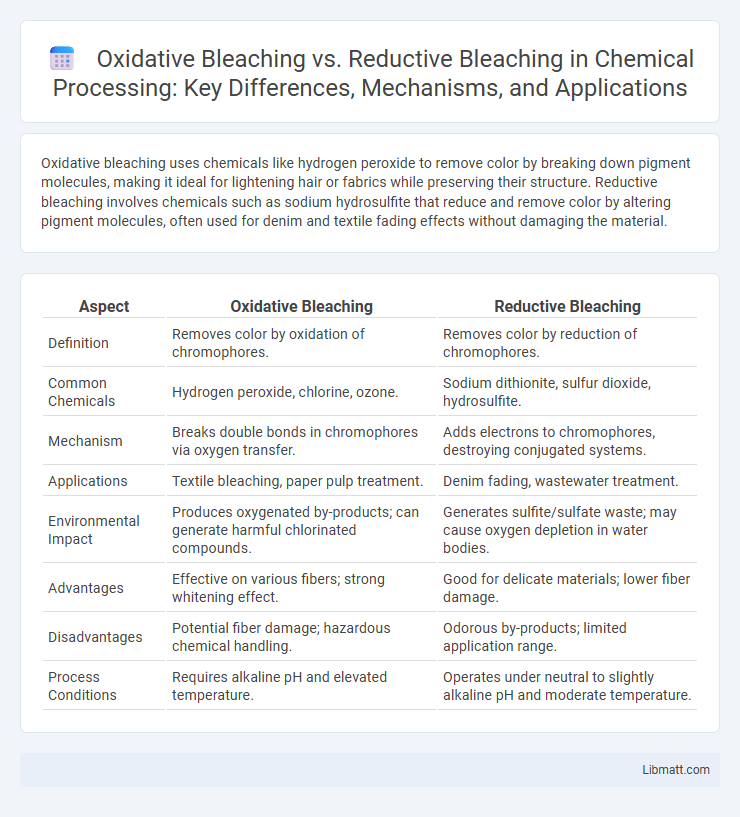Oxidative bleaching uses chemicals like hydrogen peroxide to remove color by breaking down pigment molecules, making it ideal for lightening hair or fabrics while preserving their structure. Reductive bleaching involves chemicals such as sodium hydrosulfite that reduce and remove color by altering pigment molecules, often used for denim and textile fading effects without damaging the material.
Table of Comparison
| Aspect | Oxidative Bleaching | Reductive Bleaching |
|---|---|---|
| Definition | Removes color by oxidation of chromophores. | Removes color by reduction of chromophores. |
| Common Chemicals | Hydrogen peroxide, chlorine, ozone. | Sodium dithionite, sulfur dioxide, hydrosulfite. |
| Mechanism | Breaks double bonds in chromophores via oxygen transfer. | Adds electrons to chromophores, destroying conjugated systems. |
| Applications | Textile bleaching, paper pulp treatment. | Denim fading, wastewater treatment. |
| Environmental Impact | Produces oxygenated by-products; can generate harmful chlorinated compounds. | Generates sulfite/sulfate waste; may cause oxygen depletion in water bodies. |
| Advantages | Effective on various fibers; strong whitening effect. | Good for delicate materials; lower fiber damage. |
| Disadvantages | Potential fiber damage; hazardous chemical handling. | Odorous by-products; limited application range. |
| Process Conditions | Requires alkaline pH and elevated temperature. | Operates under neutral to slightly alkaline pH and moderate temperature. |
Introduction to Bleaching Processes
Oxidative bleaching uses agents like hydrogen peroxide to break down and remove colored compounds by adding oxygen, making it effective for whitening textiles and paper. Reductive bleaching employs chemicals such as sodium dithionite to remove color by reducing chromophores, often preferred for delicate fabrics and fibers sensitive to oxidation. Your choice of bleaching process depends on the material's properties and desired outcomes, ensuring optimal color removal with minimal damage.
What is Oxidative Bleaching?
Oxidative bleaching is a chemical process that uses oxidizing agents, such as hydrogen peroxide or chlorine compounds, to break down colored compounds in materials like textiles, hair, or pulp, effectively removing stains or discoloration. This method alters the chromophores by adding oxygen or removing electrons, resulting in the lightening or whitening of the substrate. Your materials achieve brighter, more vibrant results without compromising structural integrity when oxidative bleaching is properly applied.
What is Reductive Bleaching?
Reductive bleaching is a chemical process that removes color from materials by breaking down chromophores through reduction reactions, often using agents such as sodium hydrosulfite or thiourea dioxide. Unlike oxidative bleaching, which uses oxidizing agents like hydrogen peroxide to degrade color, reductive bleaching targets stains or dyes in textiles, paper, and hair by converting them into colorless compounds. Your choice of reductive bleaching is ideal for delicate fabrics and substrates sensitive to harsh oxidizing chemicals.
Key Chemical Principles in Bleaching
Oxidative bleaching employs strong oxidizing agents like hydrogen peroxide or chlorine to break down chromophores by adding oxygen or removing electrons, effectively destroying color-causing molecules. Reductive bleaching involves the use of reducing agents such as sodium hydrosulfite or thiourea dioxide, which donate electrons to chromophores, converting them into colorless or less colored compounds by breaking double bonds or altering molecular structures. The key chemical principle in oxidative bleaching is electron removal (oxidation), whereas reductive bleaching relies on electron addition (reduction) to achieve the decolorization of fabrics or materials.
Common Agents Used in Oxidative Bleaching
Common agents used in oxidative bleaching include hydrogen peroxide, sodium hypochlorite, and chlorine dioxide, which effectively break down chromophores by adding oxygen atoms. These chemicals target and alter pigment molecules in fabrics and hair, leading to a brighter, lighter appearance. Your choice between oxidative and reductive bleaching depends on the material being treated and desired results.
Common Agents Used in Reductive Bleaching
Reductive bleaching commonly utilizes sodium hydrosulfite, thiourea dioxide, and sodium borohydride as key agents due to their strong electron-donating properties. These agents effectively break down chromophores in fibers, especially in textiles and hair treatment, by reducing double bonds and color-causing groups. Unlike oxidative bleaching, which relies on hydrogen peroxide or chlorine compounds, reductive bleaching offers a gentler approach suitable for delicate materials sensitive to oxidative damage.
Comparison of Bleaching Efficiency
Oxidative bleaching uses strong oxidizing agents like hydrogen peroxide or chlorine, effectively breaking down chromophores to produce brighter results with higher whitening power. Reductive bleaching relies on reducing agents such as sodium dithionite, targeting specific discolorations without damaging the fabric, offering gentler processing but often lower overall bleaching efficiency. Your choice depends on the substrate sensitivity and desired brightness, with oxidative methods generally providing superior whitening for most applications.
Environmental Impact of Bleaching Methods
Oxidative bleaching typically relies on hydrogen peroxide or chlorine-based agents, which can generate harmful byproducts such as chlorinated organic compounds, posing risks to aquatic ecosystems and contributing to water pollution. Reductive bleaching uses sulfur-containing agents like sodium dithionite, producing sulfur-containing waste that demands careful management due to potential odor issues and toxicity if released untreated. Advances in enzymatic and oxygen-based bleaching systems aim to minimize environmental impact by reducing hazardous chemical use and promoting biodegradability in bleaching effluents.
Safety Considerations in Bleaching Operations
Oxidative bleaching involves chemicals like hydrogen peroxide that release oxygen radicals, posing risks such as skin irritation and respiratory issues if not handled with proper protective equipment. Reductive bleaching uses agents like sodium dithionite, which can produce harmful sulfurous gases requiring adequate ventilation and careful storage to prevent explosions or toxic exposure. Ensuring your safety during bleaching operations includes using appropriate personal protective gear, working in well-ventilated areas, and following strict handling protocols tailored to the specific bleaching method.
Choosing the Right Bleaching Method
Choosing the right bleaching method depends on the substrate and desired outcome, with oxidative bleaching using agents like hydrogen peroxide to remove color by oxidation, ideal for textiles and hair. Reductive bleaching employs reducing agents such as sodium dithionite, effectively removing dyes from fabrics without damaging fiber integrity. Evaluating factors like material sensitivity, colorfastness, and environmental impact ensures selection of the most appropriate bleaching technique for optimal results.
Oxidative bleaching vs reductive bleaching Infographic

 libmatt.com
libmatt.com